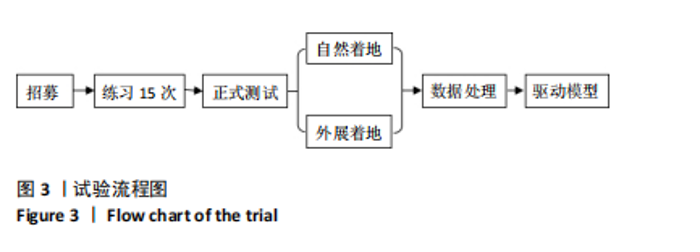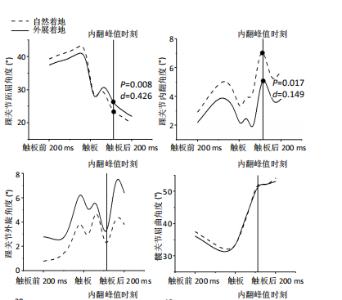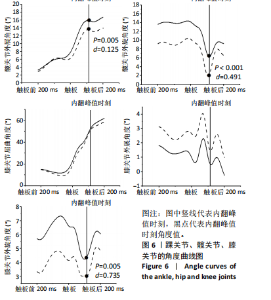Chinese Journal of Tissue Engineering Research ›› 2025, Vol. 29 ›› Issue (24): 5109-5115.doi: 10.12307/2025.739
Previous Articles Next Articles
Increasing foot toe-out angle reduces strain on the anterior talofibular ligament and calcaneofibular ligament during drop-landing with ankle inversion
Zhu Xiaoxue1, Zhang Teng1, Song Qingqing1, Luo Xin1, Zhang Hengshuo2, Wang Dan3, Qiu Jihong4, Wei Feng5, Song Qipeng1
- 1School of Sport and Health, Shandong Sport University, Jinan 250102, Shandong Province, China; 2Wolfson School of Mechanical, Electrical and Manufacturing Engineering, Loughborough University, Loughborough, LE113TU, UK; 3School of Athletic Performance, Shanghai University of Sport, Shanghai 200438, China; 4School of Exercise and Health, Shanghai University of Sport, Shanghai 200438, China; 5Orthopaedic Biomechanics Laboratories, Michigan State University, East Lansing, MI 48824, USA
-
Received:2024-08-21Accepted:2024-10-25Online:2025-08-28Published:2025-01-24 -
Contact:Song Qipeng, PhD, Professor, School of Sport and Health, Shandong Sport University, Jinan 250102, Shandong Province, China -
About author:Zhu Xiaoxue, Master’s candidate, School of Sport and Health, Shandong Sport University, Jinan 250102, Shandong Province, China -
Supported by:the National Natural Science Foundation of China, No. 12102235 (to SQP); the Youth Boosting Program of the National Team of the General Administration of Sport of China, No. 23QN009 (to SQP)
CLC Number:
Cite this article
Zhu Xiaoxue, Zhang Teng, Song Qingqing, Luo Xin, Zhang Hengshuo, Wang Dan, Qiu Jihong, Wei Feng, Song Qipeng. Increasing foot toe-out angle reduces strain on the anterior talofibular ligament and calcaneofibular ligament during drop-landing with ankle inversion[J]. Chinese Journal of Tissue Engineering Research, 2025, 29(24): 5109-5115.
share this article
Add to citation manager EndNote|Reference Manager|ProCite|BibTeX|RefWorks
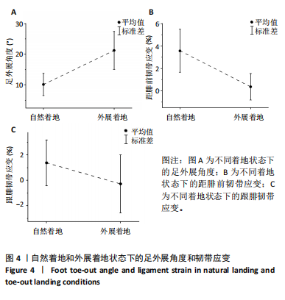
2.3 下落跳测试结果 Shapiro-Wilk检验结果显示,足外展角度、距腓前韧带、跟腓韧带应变以及踝关节、髋关节和膝关节角度数据均呈正态分布,因此使用配对样本t检验和Pearson相关分析对数据进行统计分析。 主要结局:在自然着地状态下,足外展角度为(10.50±3.59)°,而在外展着地状态下,足外展角度显著增加为(21.28±6.19)°(P < 0.001,Cohen’s d=2.13)。与自然着地状态相比,外展着地状态下的距腓前韧带应变显著降低[自然着地:(3.57±1.92)%,足外展着地:(0.36±1.18)%,P < 0.001, Cohen’s d=2.01],跟腓韧带应变显著降低[自然着地:(1.38±1.80)%,足外展着地:(-0.28±2.29)%, P=0.003,Cohen’s d=0.81],见图4。"

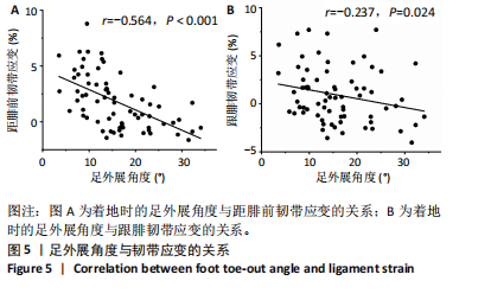
次要结局:着地时的足外展角度与距腓前韧带应变呈强负相关(r=-0.564,P < 0.001),与跟腓韧带应变呈弱负相关(r=-0.237,P=0.024),见图5。 次要结局:与自然着地状态相比,外展着地状态下内翻峰值时刻的踝关节跖屈角度显著增加[自然着地:(23.49±5.51)°,外展着地:(26.57±8.60)°,P=0.008,Cohen’s d=0.43],髋关节外展角度显著增加[自然着地:(1.42±6.16)°,外展着地:(0.67±5.81)°,P=0.005,Cohen’s d=0.13],髋关节外旋角度显著增加[自然着地:(2.97±4.04)°,外展着地:(4.88±3.77)°,P < 0.001,Cohen’s d=0.49],膝关节外展角度显著增加[自然着地:(2.15±5.90)°,外展着地:(6.85±6.85)°,P=0.005,Cohen’s d=0.74],而踝关节内翻角度显著减小[自然着地:(7.01±7.46)°,外展着地:(5.93±7.08)°,P=0.017,Cohen’s d=0.15],见图6。"

| [1] FONG DT, HONG Y, CHAN LK, et al. A systematic review on ankle injury and ankle sprain in sports. Sports Med. 2007;37(1):73-94. [2] CAVAZOS GJ JR, HARKLESS LB. The epidemiology, evaluation, and assessment of lateral ankle sprains in athletes. J Sports Med Ther. 2021;6(2):008-017. [3] BIELSKA IA, WANG X, LEE R, et al. The health economics of ankle and foot sprains and fractures: A systematic review of English-language published papers. Part 2: The direct and indirect costs of injury. Foot (Edinb). 2019;39:115-121. [4] NELSON AJ, COLLINS CL, YARD EE, et al. Ankle injuries among United States high school sports athletes, 2005-2006. J Athl Train. 2007;42(3):381-387. [5] BAUMHAUER JF, ALOSA DM, RENSTRÖM AF, et al. A prospective study of ankle injury risk factors. Am J Sports Med. 1995;23(5):564-570. [6] LYTLE JB, PARIKH KB, TARAKEMEH A, et al. Epidemiology of Foot and Ankle Injuries in NCAA Jumping Athletes in the United States During 2009-2014. Orthop J Sports Med. 2021;9(4):2325967121998052. [7] MCKAY GD, GOLDIE PA, PAYNE WR, et al. Ankle injuries in basketball: injury rate and risk factors. Br J Sports Med. 2001;35(2):103-108. [8] BRINER WW JR, KACMAR L. Common injuries in volleyball. Mechanisms of injury, prevention and rehabilitation. Sports Med. 1997;24(1):65-71. [9] KOBAYASHI T, GAMADA K. Lateral Ankle Sprain and Chronic Ankle Instability: A Critical Review. Foot Ankle Spec. 2014;7(4):298-326. [10] LI Q, LI Y, SHAN J, et al. Prevalence and Injury Patterns of CFL Injury in Chronic Lateral Ankle Instability: An Observational Cross-Sectional Study Using Ultrasound. J Foot Ankle Surg. 2024;63(1):27-32. [11] MATSUI K, TAKAO M, TOCHIGI Y, et al. Anatomy of anterior talofibular ligament and calcaneofibular ligament for minimally invasive surgery: a systematic review. Knee Surg Sports Traumatol Arthrosc. 2017;25(6):1892-1902. [12] RENSTROM P, WERTZ M, INCAVO S, et al. Strain in the lateral ligaments of the ankle. Foot Ankle. 1988;9(2):59-63. [13] YILDIZ S, YALCIN B. The anterior talofibular and calcaneofibular ligaments: an anatomic study. Surg Radiol Anat. 2013;35(6):511-516. [14] LUNDBERG A, SVENSSON OK, BYLUND C, et al. Kinematics of the ankle/foot complex--Part 2: Pronation and supination. Foot Ankle. 1989;9(5):248-253. [15] LI L, GOLLHOFER A, LOHRER H, et al. Function of ankle ligaments for subtalar and talocrural joint stability during an inversion movement - an in vitro study. J Foot Ankle Res. 2019;12:16. [16] FONG DT, HA SC, MOK KM, et al. Kinematics analysis of ankle inversion ligamentous sprain injuries in sports: five cases from televised tennis competitions. Am J Sports Med. 2012;40(11):2627-2632. [17] 朱晓雪,赵琼秋,张藤,等.增加着地时足外展角度可降低慢性踝关节不稳者内翻损伤的风险[J].中国组织工程研究,2025,29(9):1827-1833. [18] PATERNO MV, SCHMITT LC, FORD KR, et al. Biomechanical measures during landing and postural stability predict second anterior cruciate ligament injury after anterior cruciate ligament reconstruction and return to sport. Am J Sports Med. 2010;38(10):1968-1978. [19] HUANG Z, SHAN W, DING J, et al. Peroneal reaction time delayed but dynamic single-legged stability retained in collegiate footballers during a simulated prolonged football protocol. Res Sports Med. 2021;29(6):557-570. [20] FLEMING BC, BEYNNON BD. In vivo measurement of ligament/tendon strains and forces: a review. Ann Biomed Eng. 2004;32(3):318-328. [21] ZHANG K, LI M, YAO W, et al. Cytotoxicity of Local Anesthetics on Bone, Joint, and Muscle Tissues: A Narrative Review of the Current Literature. J Pain Res. 2023;16:611-621. [22] WEI F, BRAMAN JE, WEAVER BT, et al. Determination of dynamic ankle ligament strains from a computational model driven by motion analysis based kinematic data. J Biomech. 2011;44(15):2636-2641. [23] LIN CI, HOUTENBOS S, LU YH, et al. The epidemiology of chronic ankle instability with perceived ankle instability- a systematic review. J Foot Ankle Res. 2021;14(1):41. [24] HILLER CE, REFSHAUGE KM, BUNDY AC, et al. The Cumberland ankle instability tool: a report of validity and reliability testing. Arch Phys Med Rehabil. 2006; 87(9):1235-1241. [25] SHEPPARD JM, TRIPLETT TN. Program design for resistance training//Haff GG, Triplett TN. Essentials of Strength Training and Conditioning. Champaign, IL: Human Kinetics, 2016:439-470. [26] KHAN SS, KHAN SJ, USMAN J. Effects of toe-out and toe-in gait with varying walking speeds on knee joint mechanics and lower limb energetics. Gait Posture. 2017;53:185-192. [27] MCCAHILL J, STEBBINS J, THEOLOGIS T. Use of the Oxford Foot Model in clinical practice. J Foot Ankle Res. 2008;1(Suppl 1):O28. [28] VAN HOEVE S, LEENSTRA B, WILLEMS P, et al. The effect of age and speed on foot and ankle kinematics assessed using a 4-segment foot model. Medicine (Baltimore). 2017;96(35):e7907. [29] VAN MELICK N, MEDDELER BM, HOOGEBOOM TJ, et al. How to determine leg dominance: The agreement between self-reported and observed performance in healthy adults. PLoS One. 2017;12(12):e0189876. [30] 王相英.高低运动技能者练习伴随低估效应的实验研究[J].中国特殊教育, 2017(6):91-96. [31] GEHRING D, FASCHIAN K, LAUBER B, et al. Mechanical instability destabilises the ankle joint directly in the ankle-sprain mechanism. Br J Sports Med. 2014; 48(5):377-382. [32] MOKHTARZADEH H, YEOW CH, GOH JCH, et al. Antagonist muscle co-contraction during a double-leg landing maneuver at two heights. Comput Methods Biomech Biomed Engin. 2017;20(13):1382-1393. [33] MCILROY WE, MAKI BE. Preferred placement of the feet during quiet stance: development of a standardized foot placement for balance testing. Clin Biomech (Bristol, Avon). 1997;12(1):66-70. [34] BECHARD DJ, BIRMINGHAM TB, ZECEVIC AA, et al. Toe-out, lateral trunk lean, and pelvic obliquity during prolonged walking in patients with medial compartment knee osteoarthritis and healthy controls. Arthritis Care Res (Hoboken). 2012; 64(4):525-532. [35] BENNOUR S, ULRICH B, LEGRAND T, et al. Effects of foot progression angle on knee biomechanics during gait modification. Comput Methods Biomech Biomed Engin. 2017;20(sup1):17-18. [36] KOSHINO Y, ISHIDA T, YAMANAKA M, et al. Toe-in Landing Increases the Ankle Inversion Angle and Moment During Single-Leg Landing: Implications in the Prevention of Lateral Ankle Sprains. J Sport Rehabil. 2017;26(6):530-535. [37] BHASKARAN D, WORTLEY M, CHEN Q, et al. Effect of a combined inversion and plantarflexion surface on anklekinematics and EMG activities in landing. J Sport Health Sci. 2015;4(4):377-383. [38] WEI F, HUNLEY SC, POWELL JW, et al. Development and validation of a computational model to study the effect of foot constraint on ankle injury due to external rotation. Ann Biomed Eng. 2011;39(2):756-765. [39] WEI F, FONG DT, CHAN KM, et al. Estimation of ligament strains and joint moments in the ankle during a supination sprain injury. Comput Methods Biomech Biomed Engin. 2015;18(3):243-248. [40] COLVILLE MR, MARDER RA, BOYLE JJ, et al. Strain measurement in lateral ankle ligaments. Am J Sports Med. 1990;18(2):196-200. [41] COHEN J. Statistical Power Analysis for the Behavioral Sciences. 2nd ed. New York, NY: Psychology Press. 1988. [42] WRIGHT IC, NEPTUNE RR, VAN DEN BOGERT AJ, et al. The influence of foot positioning on ankle sprains. J Biomech. 2000;33(5):513-519. [43] FONG DTP, MOK KM, THOMPSON IM, et al. A lateral ankle sprain during a lateral backward step in badminton: A case report of a televised injury incident. J Sport Health Sci. 2023;12(1):139-144. [44] MOK KM, FONG DT, KROSSHAUG T, et al. Kinematics analysis of ankle inversion ligamentous sprain injuries in sports: 2 cases during the 2008 Beijing Olympics. Am J Sports Med. 2011;39(7):1548-1552. [45] GARRICK JG. The frequency of injury, mechanism of injury, and epidemiology of ankle sprains. Am J Sports Med. 1977;5(6):241-242. [46] ATTARIAN DE, MCCRACKIN HJ, DEVITO DP, et al. A biomechanical study of human lateral ankle ligaments and autogenous reconstructive grafts. Am J Sports Med. 1985;13(6):377-381. [47] SIEGLER S, CHEN J, SCHNECK CD. The three-dimensional kinematics and flexibility characteristics of the human ankle and subtalar joints--Part I: Kinematics. J Biomech Eng. 1988;110(4):364-373. [48] TAKAO M, LOWE D, OZEKI S, et al. Strain patterns in normal anterior talofibular and calcaneofibular ligaments and after anatomical reconstruction using gracilis tendon grafts: A cadaver study. BMC Musculoskelet Disord. 2021;22(1):558. [49] HA SC, FONG DT, CHAN KM. Review of ankle inversion sprain simulators in the biomechanics laboratory. Asia Pac J Sports Med Arthrosc Rehabil Technol. 2015;2(4):114-121. |
| [1] | Li Shuai, Liu Hua, Shang Yonghui, Liu Yicong, Zhao Qihang, Liu Wen. Stress distribution on the maxilla when wearing the Twin-block appliance for Class II malocclusion [J]. Chinese Journal of Tissue Engineering Research, 2025, 29(5): 881-887. |
| [2] | Wang Feng, Cao Chunfeng, He Chao, Zhang Tao, Zhou Zixian, Zhu Fengchen. All-inside versus traditional techniques of anterior cruciate ligament reconstruction: meta-analysis of therapeutic efficacy and radiological outcomes [J]. Chinese Journal of Tissue Engineering Research, 2025, 29(35): 7629-7638. |
| [3] | Akliya·Anwar, Nafisa·Gupur, Baibugafu·Yelisi, Zilalai·Gulaiti, Guzalnur·Emrayim, Nijat·Tursun. Dynamic stress analysis of maxillary sinus lifting without bone grafting and with immediate loading after bone grafting [J]. Chinese Journal of Tissue Engineering Research, 2025, 29(30): 6416-6425. |
| [4] | Zhu Zheyue, Zhang Chen, Ge Ying, Xue Han, Li Ruochen, Wu Guangwei, Ma Rui. Quantitative evaluation of knee laxity after partial anterior cruciate ligament injury with a novel digital arthrometer [J]. Chinese Journal of Tissue Engineering Research, 2025, 29(27): 5795-5801. |
| [5] | Liu Danyu, Jiang Tingting, Jiang Zhixiu, Ji Yuchen, Cao Yilin, Wang Lei, Su Yucheng, Wang Xinyu. Personalized GYROID condylar prosthesis: design and finite element analysis [J]. Chinese Journal of Tissue Engineering Research, 2025, 29(17): 3548-3556. |
| [6] | Yang Junliang, Lu Tan, Xu Biao, Jiang Yaqiong, Wang Fucheng. Three-dimensional finite element analysis of effects of partial anterior cruciate ligament rupture on knee joint stress [J]. Chinese Journal of Tissue Engineering Research, 2024, 28(9): 1347-1353. |
| [7] | Bai Chen, Yang Wenqian, Meng Zhichao, Wang Yuze. Strategies for repairing injured anterior cruciate ligament and promoting graft healing [J]. Chinese Journal of Tissue Engineering Research, 2024, 28(9): 1457-1463. |
| [8] | Wang Duoduo, Lyu Jie, Guo Panjing, Ding Lijun, Cao Jinfeng, Zhou Nan, Lyu Qiang. Effect of total ligament superimposed injury on biomechanical characteristics of the lumbar spine [J]. Chinese Journal of Tissue Engineering Research, 2024, 28(33): 5249-5256. |
| [9] | Tu Hudi, Jurat·Matrozi, Zheng Hui, Li Chaojie. Finite element analysis of talus cartilage before and after anterior talofibular ligament injury [J]. Chinese Journal of Tissue Engineering Research, 2024, 28(18): 2795-2799. |
| [10] | Xue Boshi, Lin Changrui, Zheng Liangliang, Yang Chen, Zhou Zhipeng. Core stability training reduces risk of anterior cruciate ligament injury in landing movements [J]. Chinese Journal of Tissue Engineering Research, 2024, 28(16): 2467-2472. |
| [11] | Liu Guangluan, Guo Zonglei, Ge Jin, Huang Dong, Wang Yehua. Anatomic risk factors for medial meniscus posterior root tears combined with anterior cruciate ligament injuries [J]. Chinese Journal of Tissue Engineering Research, 2023, 27(5): 663-668. |
| [12] | Li Shihao, Li Qi, Li Zhen, Zhang Yuanyuan, Liu Miaomiao, Ouyang Yi, Xu Weiguo. Plantar pressure and gait analysis in patients with anterior cruciate ligament injury and reconstruction [J]. Chinese Journal of Tissue Engineering Research, 2023, 27(4): 626-631. |
| [13] | Shi Xu, Zuo Hua, Wang Yuxing, Yao Xiang, Yuan Jishan. Finite element analysis of the influence of lateral ankle collateral ligament injury on ankle joint stability and cartilage contact strain [J]. Chinese Journal of Tissue Engineering Research, 2023, 27(31): 4926-4931. |
| [14] | Li Panpan, Qing Haomiao, Ren Sixie, Zhang Yuanyuan. Correlation of medial and lateral posterior tibial slope and their differences with anterior cruciate ligament injury [J]. Chinese Journal of Tissue Engineering Research, 2023, 27(27): 4379-4384. |
| [15] | Zhang Duo, Shan Jixin. Alteration in knee and ligament functions in patients with knee ligament injury under aerobic training intervention mode [J]. Chinese Journal of Tissue Engineering Research, 2023, 27(26): 4107-4112. |
| Viewed | ||||||
|
Full text |
|
|||||
|
Abstract |
|
|||||
